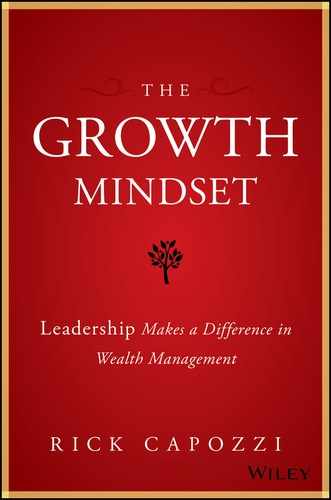PART TWO
Growing Your Wealth Management Business
Over the past 30 years, the wealth management industry has experienced phenomenal growth as well as a profound transformation. As I discussed in Part One, the catalysts of this transformation include the rise in client needs, greater levels of client sophistication, more investment choices, advanced technology, automated advice, and increased regulatory presence. Yet with all these changes, the advice business will continue to grow and flourish. It will evolve with machines and humans working together. Digital labor will only accelerate and be a major factor in how we manage money, relationships, and our time. I believe over the next 10 years the global wealth management industry will behave like a global geological system. The wealth management tectonics will cause disruption on a grand scale and will reshape the advisory landscape as we know it today. Advisors who feel they are on the hamster wheel running hard and not making any progress will feel even greater pressure because they will lose more ground. Therefore, don't wait until you lose that big relationship for your wakeup call. Start now. The secret is learning and evolving in real time.
Part Two of this book is all about growing assets, generating revenue, and building client loyalty. Growing the business starts with a conscious decision to effectively run the two parts of your business. One is managing the business and the other is growing it. If you're a sole practitioner, you must make asset growth part of your daily plan. Your foundation is great service and valued advice, but your book will not grow just because you show up and take care of your clients. To grow 10 or 20 percent or more (not including market appreciation/depreciation) you need to spend 40 percent of your time on business development activities. If you're part of a team, that 40 percent may be allocated to different members based on roles and responsibilities. Growing your practice is not a passive activity; it's a deliberate act of allocating time, investing resources, and being innovative. Yet the fact of the matter is that most advisors spend very little time hunting for new clients. Why? Because complacency sets in. For those who are serious about growth, I provide the roadmap in Part Two.
I see 11 ways to grow your business:
- If you have the resources to buy assets you should. Because of an aging advisor population this is an area that should not be overlooked. It takes a lot of time, patience, and research, not to mention money, to identify the right opportunities.
- Recruit quality advisors. Recruiting a junior advisor on your team can have a major impact.
- Ask clients for introductions. This is the most cost‐effective way to grow. Over 50% of new business comes from introduction.
- Create strategic alliances.
- Focus on Centers of Influence (COIs) and networking.
- Target marketing programs.
- Host client events.
- Create a client board of advisors.
- Present seminars.
- Join a team or expand your team.
- Leverage social media.
Every one of these 11 strategies requires four things: a growth mindset, a willingness to invest back into the business, a competent team, and most of all the discipline to stay with the plan. For example, you wake up one day saying you will focus on seminars and after two seminars you conclude it doesn't work. It works if you are committed for 12 months with a plan and right strategy. The same is true for all business development activities; you can't start and stop. Just like diets don't work but changing your lifestyle does. The best advisors in our industry haven't just embraced the changes transforming wealth management but have turned the speed of business change to their advantage. As a result they are always focused on business development, employing new technology to automate processes, outsourcing where possible to create more capacity, and spending more time with clients and prospects. The future will demand that you take advantage of technology to reduce the “busy” work. If you enjoy spending time doing something an algorithm can do, you will slowly become less relevant.
Business Growth Model

Start with your purpose; what are you hoping to accomplish? That will lead into vision. Business development doesn't happen unless you have a strong “why.” Just for the record, business plans work; therefore, that's a good place to start. Incorporate a life plan as well, one that must be focused and monitored on an ongoing basis. A life plan should be a dynamic and a collaborative effort. It is your blueprint. It should not be more than three or four pages long. The following chapters should give you the information you need to build a customized plan. Start with one‐year and three‐year goals. Client retention, service excellence, team structure, business development, and expanding the client relationship are some examples. Are you the primary advisor for your 50 clients? If not, why not? What steps can you take to become the primary advisor? What additional advice, service, and solutions can you provide? Remember the core of wealth management is to build relationships based on a well‐developed and fully integrated plan for achieving long‐term wealth goals.
